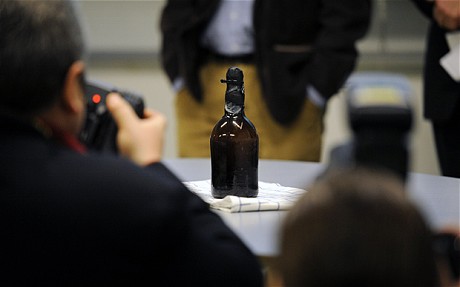
Beer DNA
Scene One. A CSI lab. Downtown. About 10.30am.
 [The camera pans across the dimly lit forensic science lab where a lab-coated technician peers through the eyepiece of a shiny electron microscope. The contents of the slide beneath the 1000x lens are projected onto a plasma screen, strange coloured shapes coming into sharp focus as another technician enters the room and stares, transfixed before the emerging image.]
[The camera pans across the dimly lit forensic science lab where a lab-coated technician peers through the eyepiece of a shiny electron microscope. The contents of the slide beneath the 1000x lens are projected onto a plasma screen, strange coloured shapes coming into sharp focus as another technician enters the room and stares, transfixed before the emerging image.]
“What is it?” he enquires as the first scientist moves away from the microscope and fires up the mass spectrometer, gas chromatograph machine and the George Foreman dual-level toaster oven.
“It’s beer, Jim, but not as we know it”, replies his colleague as he reaches for the Tip Top Hi Fibre. “And, if my calculations are correct I should be able to extract enough base material to re-constitute the original brew data. If my other calculations are correct it should go very nicely with this cheese toasty.”
He sets his lunch down beside a bottle, its wax seal carefully removed but its label long gone, replaced by barnacles and centuries of seawater preservation.
This is CSI – Burton-on-Trent.
This fanciful (but not altogether unfeasible) television concept is not as far away from reality as you may at first guess. Finnish scientists are confident they can extract the recipe from a 19th century beer bottle recovered last year from the wreckage of a ship recovered from the Baltic Sea. It is hoped that using modern technology they can identify the yeast and other microbial evidence and then examine the DNA of the dead cells to determine what malts, hops and other raw materials were used to brew the beer.
If all goes well, scientists at the VTT Technical Research Centre of Finland might just be able to harvest some viable yeast cells and, with other lactic acid bacteria present in the bottles re-create this dark foamy ale.
Five bottles of the beer were found by divers recovering 168 bottles of champagne thought to be part of the cargo of a two-masted ship which went down between Copenhagen and St Petersburg proving once again that an interest in the grape can often lead to the wonders of the grain.
[Closing Scene. CSI lab. Beer O’Clock. The scientists head off to the local.]
“Once we’ve re-brewed the beer we’ll have to think of a catchy name for it, won’t we … better get onto Marketing eh?”
“Yeah … reckon it’ll hurt the brand image if we have to contract brew it?”
“Whadya reckon will happen if we barrel-age a beer that’s been on the ocean floor for 200 years …?”
“How many votes will get into the Taphouse Top 100 number one spot?” … Just askin’…”




